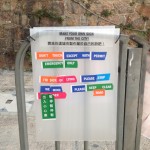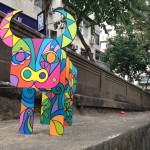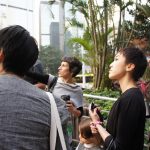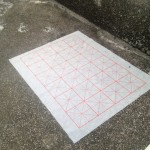Meikilee’s guitar performance captures the special acoustics of the stairs, acting as a reminder of the potential Hong Kong’s stairs have for occupation by live performances. 《風輕過》李美麒 木吉他彈奏展演 李美麒的吉他彈奏演出捕捉樓梯空間的特殊音響效果, 讓人意識到香港城樓梯間現場表演場的潛能。
Artwork
Hirano’s two pieces pay homage to the Hong Kong martial arts icon Bruce Lee in both their subject matter and their style. Quick and playful, yet serious, they are a tribute, as well as an example of working “on the fly” in a public space. 藝術家這兩件作品在公共空間即場繪就,下筆神速如飛, 畫風既富於玩味,又透著嚴謹,向香港武術泰斗李小龍致敬。
The clarity with which we can hear sounds as we walk by them depends upon our pace. We often ignore individual sounds around us, treating them as a single cloud of noise. In can you hear ( ) sing?, Au places a recording of hummingbirds at fixed points along the stairs of Chancery Lane. Pedestrians who slow down to listen to the recording become the audience for the work — hearing sounds that would otherwise be inseparable from the surrounding noise of the city. 走路時聽到的聲音有多清晰,跟步伐的快慢彼此緊扣著。我們也許常常忽略身邊聲音之美,只當成噪音。作品 《喚》在舊樓梯間幾個位置放上裝置,播放城市中鳥鳴的錄音。行人在樓梯上放慢腳步,成為作品的聽眾,並意識到其他與鳥鳴相互輝映的環境聲音。
Chairs with legs adjusted for the stairs were “found” by Wong along Pound Lane. Wong extends this community-built seating to fill half the staircase, measuring out the width of the proposed escalator, as a way to both raise awareness about the potential impact of the escalator, and also to celebrate the stairs as a public gathering place. 藝術家「發現」磅巷街坊將椅子兩腳截短,以便放在樓 梯上,遂把這組由社區共同發明的座椅進一步延展,令 其佔整條樓梯的一半,相當於扶手電梯項目的覆蓋闊度。作品一方面令人留意到扶手電梯的潛在影響,亦讚揚樓梯作為公共休憩空間的價值。
In this piece, Toland and Hambley repurpose the found poetry from often-overlooked signage in Hong Kong. The signs include text such as “Look Right”; “Disinfect every two hours”; or “Disturbed Slopes Ahead”. In their interactive installation on the stairs that lead up to the Hong Kong Museum of Medical Sciences, passers-by reassemble these words to form their own poetry from the city. The words and their often random transposition offer a reflection on the subtle anxiety whispering below the surface of Hong Kong’s collective subconscious: the fear of contagion, disease, and engulfment. The title of the work recalls this area’s history as the site of a devastating plague outbreak in 1894. 裝置作品《每兩小時消毒一次!》裏,兩位藝術家以受忽略的告示牌文字為出發點,例如「向右看」、「每兩小時消毒一次」、「前面有斜坡」等,重新利用告示蘊含的詩意創作。參加者可以沿著前往香港醫學博物館的展覽樓梯,把告示字條撕下重組,在城市裏編寫屬於自己的詩。告示文字隨機組合,讓人聯想到這城市因瘟疫 和疾病而潛藏的集體焦慮和恐懼。作品題目《每兩小時 消毒一次!》回應這段樓梯曾於一八九四年爆發鼠疫的歷史。
Ho’s colourful and playful sculpture offers passers-by a visual cue to connect with the history of Pound Lane. The installation enriches the everyday walking environment while also activating an awareness of the past. 藝術家以這件俏皮斑瓓的雕塑作品為視覺線索,裝置作品豐富了這個日常步行環境,亦讓路人關注這段樓梯的歷史。
Law and Wong developed a Facebook page to post stories and personal histories about life on Pound Lane. Some of these were collected while chatting with residents of the area and others were posted by the residents and visitors themselves. Excerpts from these stories, where Pound Lane played a critical part, were included in the paper “escalator” installed on the stairs of Pound Lane. 兩位藝術家在社交網站 Facebook 設立專頁,分享磅巷 的歷史軼事,有的來自與附近居民閒聊所得,有的則由 磅巷居民和訪客撰寫。藝術家抽取與磅巷息息相關的故事,陳列在「紙電梯」上,再將其置放在磅巷樓梯上。
Yan’s Livelihood photo series documents makeshift metal structures erected by small stall-holders. These structures show adaptations to what were meant to be regulated and standardized stalls. As street stalls and their owners disappear from Hong Kong’s streets, erased as the city redevelops, the preservation and revitalization of these structures and this way of living offers an alternative means of livelihood that counters the city’s tightly controlled commercial environment. Yan’s bamboo structure installation is inspired by the tradition of hanging out laundry, vegetables, or sh to dry — a common scene in the city’s past. 《檔口》攝影系列作品紀錄香港小販攤檔「朝行晚拆」的伸縮金屬結構。這種靈活的結構體現檔主面對排檔標 準化和規範化的適應力。城市不斷發展,小販和攤檔慢 慢被重建的巨浪湮沒,在街頭巷尾消失。可是,這種檔 口結構和小販謀生方式的保育和活化,正好成為對店 鋪的抗衡,以抗衡這個高度規範化的商業社會。《檔口 ──華寧里》的竹竿結構裝置,靈感來自用竹竿晾曬衣物的傳統。過去,這是香港家家戶戶常見的景象。
step up! was launched officially with an opening tour guided by the project curator, Melissa Cate Christ, on December 7th, Saturday, with the project team and featured artists. The tour started at Dominion Garden in Wan Chai and went through the installations and some other 'secret' stairs and finished in Tai Ping Shan. It was a great way to celebrate and learn about the complex pedestrian network of Hong Kong stairs. 拾級!終於起動了!今個星期六(12 月7 號)將由是此展覽策劃人 Melissa Cate Christ 和團隊及參與的眾藝術家帶大家步行一趟港島區的樓梯,由灣仔至上環,沿途感受樓梯為鄰里帶來的文化和探訪藝術品。齊來參與這次導賞,讓我們一起探索在香港的秘密樓梯和認識有關樓梯的文化。集合地點是灣仔東美花園。到時見!
Wong works with discarded objects, imagining and reconstructing their secret histories. He is interested in the relationships between human beings, spaces, and living environments. In Please _______Graffiti, he constructed an amorphous sculpture from a seemingly unwanted found material, cardboard boxes. The installation was removed overnight by local cardboard collectors (cardboard is worth HK$0.70/kilo). The curator responded by putting up notices appealing for information to help find Wong’s “Lost Art”. 黃氏以棄置物品創作,想像及重組其背後鮮為人知的故事,尤其對人、空間、生活環境三者間的關係深感興趣。 《請 ________ 塗鴉》用棄置紙箱砌成雕塑不能名狀。紙 箱看似廢物,雕塑卻在一夜之間被本地執拾紙皮為生的人搬走(在香港,紙皮回收價每公斤約值港幣七角)。策展人為回應此事,遂貼上尋物告示,尋找 ________ 的藝術品。
The choreography for the contemporary dance performance Rhythm-analysis: Time Punching Machine consists of physical movements derived from daily gestures on stairs, such as stepping-up and down, turning, and squatting. Through an aesthetic transformation of everyday life set to live music, and using the stairs themselves as an instrument, Kiwi Chan offers the public an imaginative interaction with these “hidden” urban gestures. 當代舞蹈作品︽節奏分析:打咭鐘︾將樓梯上的日常姿勢幻化為舞步:踏上、行落、轉身、蹲下,配上現場演奏音樂,以樓梯為樂器,藝術家讓公眾與城中這些﹁被隱藏﹂的姿態來一場充滿想像的互動。
A group of residents from the Tai Ping Shan neighbourhood in Sheung Wan formed the Pound Lane Concern Group (PLCG) to oppose government plans to build an escalator Pound Lane, a historic stair street. Katty Law and Kit Yeung, both founding members of the PLCG, lead visitors on an afternoon walk in the area where Pound Lane is located, Tai Ping Shan. The tour points out some of Pound Lane’s historical features and offers an insight into why an escalator would destroy the character of this peaceful street that is highly valued by those who reside in its vicinity. 一批上環磅巷居民成立磅巷關注組︵PLCG︶,反對政府在此舊式樓梯街道擬建扶手電梯。關注組其中兩位成員羅雅寧和楊子傑,帶領參加者在午間漫步磅巷所在的太平山區,探索其歷史特色,從而指出扶手電梯項目對磅巷的影響和破壞,和居民對這個寧靜小區的珍惜和尊重。
A portion of the wall between Blake Garden and Pound Lane is scheduled for demolition to make way for the proposed escalator. Fung's piece offers an opportunity to inhabit the physical and temporal space in-between Pound Lane and Blake Garden. 根據政府的磅巷扶手電梯項目計劃,卜公花園一幅歷史 悠久的擋土牆將遭拆除,以便騰出空間興建扶手電梯。裝置作品《梯》讓人親身體驗磅巷和卜公花園之間的這片獨特空間。
Exhausted by climbing up the stairs, most people rest at intervals and then carry on to finish their journey. This has a resonance with the practice of calligraphy. In this piece, Tai pastes patterned Chinese calligraphy-practice paper onto a fight of stairs. This fragile red carpet speaks both to the threatened condition of built heritage in Hong Kong and to ideas of determination and endurance.













